 Remove scatter rugs, electrical cords, spills, and anything else that may cause you to fall.
Remove scatter rugs, electrical cords, spills, and anything else that may cause you to fall.- In the bathroom, use nonslip bath mats, grab bars, a raised toilet seat, and a shower tub seat.
- Simplify your household to keep the items you need handy and everything else out of the way.
- Use a backpack, fanny pack, apron, or briefcase to help you carry things around.
Proper Positioning
- The top of your crutches should reach between 1 and 1.5 inches below your armpits while you stand up straight.
- The handgrips of the crutches should be even with the top of your hip line.
- Your elbows should bend a bit when you use the handgrips.
- Hold the top of the crutches tightly to your sides, and use your hands to absorb the weight. Don't let the tops of the crutches press into your armpits.
Walking
- Lean forward slightly and put your crutches about one foot ahead of you.
- Begin your step as if you were going to use the injured foot or leg, but shift your weight to the crutches instead of the injured foot. Your body swings forward between the crutches.
- Finish the step normally with your non-injured leg.
- When the non-injured leg is o the ground, move your crutches ahead in preparation for the next step.
- Keep focused on where you are walking, not on your feet.
Sitting
- Back up to a sturdy chair.
- Put your injured foot in front of you and both crutches in one hand.
- Use the other hand to feel for the seat of your chair.
- Slowly lower yourself into it. Lean your crutches upside down in a handy location. (Crutches tend to fall over when they are stood on their tips.)
- To stand up, inch yourself to the front of the chair. Hold both crutches in the hand on your good leg side.
- Push yourself up and stand on the good leg.
Stairs
- To walk up and down stairs with crutches, you need to be both strong and flexible.
- Facing the stairway, hold the handrail with one hand and tuck both crutches under your armpit on the other side.
- When you're going up, lead with your good foot, keeping the injured foot raised behind you.
- When you're going down, hold your injured foot up in front, and hop down each stair on your good foot. Take it one step at a time. You may want someone to help you, at least at first.
- If you're facing a stairway with no handrails, use the crutches under both arms and hop up or down each step on your good leg, using more strength.
- An easier way is to sit on the stairs and inch yourself up and down each step. Start by sitting on the lowest stair with your injured leg out in front.
- Hold both crutches flat against the stairs in your opposite hand. Scoot your bottom up to the next step, using your free hand and good leg for support.
- Face the same direction when you go down the stairs this way.
